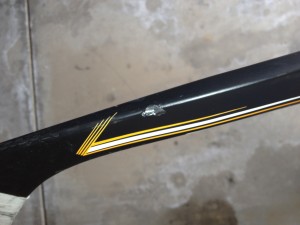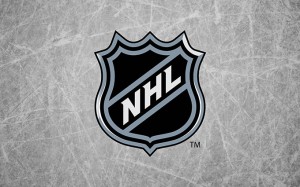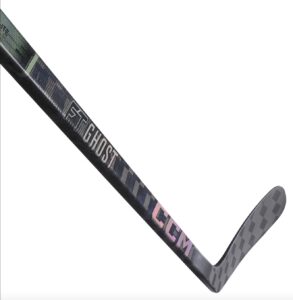We at Hockey World Blog were fortunate to receive the Dekree DC300 hockey stick for review. Based out of the Province British Columbia, Canada, Dekree focuses on engineering a quality hockey stick for adult hockey players.
Our review focuses on performance (shooting and accuracy), feel, as well as durability. Please note, my review is based off of ice hockey usage, while Chris has also reviewed the Dekree DC300 for roller hockey purposes.
 Specs: Dekree DC300, 80 flex, M3 curve (similar to Modano)
Specs: Dekree DC300, 80 flex, M3 curve (similar to Modano)
Modifications: None
Design and Construction:
Sometimes simpler is better, as the Dekree DC300 has a black base color with orange and white highlights. Dekree is written on the side, with their orange accented logo, with a few pin-stripe accents. With orange being my favorite color, you can imagine I liked it from the first glance.
Perhaps on the lower end of the intelligence spectrum when it comes to the engineering of the stick, but the Dekree DC300 is made of ultra-light carbon for a light but dependable performing hockey stick. The shaft has a double conclave shaft, a fancy term for rounder corners for better feel. Lastly, the shaft also has some tack for grip, followed with a tapered shaft that becomes narrow at the bottom, promoting better flex for a faster, harder shot.
Weight and Balance:
The stick weighs 435 grams, a light feel indeed. To compare, the Bauer Supreme TotalONE weighs only 2 grams less, weighing in at 433 grams. The Easton Stealth RS weighs 442 grams while the Reebok Ai9 come in the heaviest amongst top end sticks at 454 grams.
When it comes to balance, the stick’s weight is equally distributed, not blade heavy. The DC300 is a well balanced and feeling hockey stick.
Puck Handling/Feel:
The Dekree DC300 provides the player with an excellent feel for the puck. With its light weight and good balance, I have found myself trusting in my hands a lot more and looking up the ice for my next pass.
I left my stick at the original 60 inches as I have found myself playing defense more often. Leaving the stick at such a length has really allowed me to direct opponents to the outside with the reach, as well as striking with a quick poke-check with the light weight. Still, the height has not hindered my ability to stickhandle when needed. While going side to side with the puck you really have a great feel for the puck, even to the detail of if it is at the toe or heel, allowing the player to adjust appropriately to a quick pass or shot as it varies depending on the position of the puck on your stick.
Paired with the grip along the shaft, the stick does not slide out nor does it stick where you are unable to choke up quick in tight circumstances. The trial period of a good sticky hockey stick has come a long way, as most hockey sticks today provide that right amount of stick.
Shooting and Accuracy:
This is where the DC300 excels; shooting and accuracy.
I did not modify the stick in any way, leaving it at the 60 inch length which did not alter the 80 flex. In the past, I have always gone for a 100 flex. Perhaps an appeal to manliness, I have since changed to a lesser flex. I typically am making passes and refraining from slap-shots, taking more wrist-shots, so the lesser flex allows for an easier whip to increase power.
I still do take slap-shots from time to time, at least in warm-ups, and I have noticed my shot has not only increased in power but has increased in accuracy. In contrast to Chris, who had difficulty elevating his shots, I have not noticed any problem lifting the puck while taking a slap-shot. Also, I have not noticed the puck always lifting either; the puck goes where I want it to go.
Note: Chris has taken a few shots with my stick and was able to elevate the puck without issue.
Wrist-shots are equally as accurate. I recently found myself on a fast break-away from the right side where, as mentioned the comfort of feel and being able to skate with my head up, I spotted the low-left side of the net open and I buried it home. It was not just a matter of putting it where I wanted it, I also was able to put power behind my wrist-shot. The combination of the two left a snapshot in my memory, that may be a boastful and slightly inaccurate fishing story, that I looked like a pro on that shot.
Lastly, in terms of accuracy, it all comes down to passing. The Dekree DC300 does not fail. Instead, tape-to-tape passes come with ease. That is, of course, as long as your target does not stop skating.
 Durability:
Durability:
The DC300 is a good, solid hockey stick. However, I have a rather large gash out of the back of the stick toward the bottom. This could be because I play with some hacks, but for one reason or another this has bothered me. The gash by no means impacted performance so far, and I have had gashes in other sticks of equal if not bigger that have not bothered me one bit, but for some reason this has. Perhaps my love of the performance of stick has made me expect godly things. The reality is, the stick is dependable, and despite have a little chunk in my shaft that all hockey sticks have in time, the Dekree DC300 is very durable.
Overall Impressions:
If you happen to skip the bulk of the review, reading the overall impressions first, the Dekree DC300 is worth the $199 dollars. I was hesistant whether anyone would be willing to pay such a steep price for the product, but after testing and reviewing the performance of the DC300, I feel any buyer should not be worried and should seriously consider Dekree before making any purchases. Performance rivals top-end makers with it’s incredible light weight and good balance, its pin-point accuracy – be it wrist-shots, slap-shots or passes – and the durability of the stick. It is sad to say, but the Dekree DC300 may have replaced my love for the Blue Ice Nano Professional that I reviewed a while back. Perhaps Blue Ice Hockey’s upcoming NP-Tek might change my mind again.
Interested in purchasing the Dekree DC300? Check them out online at www.dekree.ca! Have any more questions about this stick? Feel free to contact Chris on Twitter @HWBChris or EB at EB@hockeyworldblog.com



I posted my comments under the other review of the ’90 flex’ stick, but thought to add something here as well.
Basically, I got ahold of two of these, and one broke immediately, as I was flexing it. I considered going out & buying another in 80 flex, but after my voice messages & Emails to Dekree went unanswered, I decided against it.
It’s too bad… I’ve used many sticks in my day, and the stick seems ‘above average’ to ‘better than most’, but the questionable durability & (worse) the lack of customer support are below par.
Thank you for your comment.
I’ve had no issues with the durability, as the Dekree DC300 has held up quite nicely. I wonder though, as you mentioned one of your friend received them and it seems they had some damage to begin with, if that had more to blame than the typical durability of the stick.
As for customer service, we’ve had good communications with Dekree. If you like, we can contact Dekree in an effort to put you into contact with an appropriate person to have your questions answered?
Yeah, if you could get someone to contact the me, that’d be great!
The stick that broke didn’t have a mark on it, but it was a prize in a give-away, so I have no illusions about the warranty on it.
I had hoped to replace the broken one with one in 80-flex, but was just disappointed in not getting ANY reply… even a gesture of customer support. I liked the idea of supporting a BC company. 🙂
… but not getting any response worried me about spending money on a product (if I were to buy another one) that could break on first flex when appearing intact.
The other one I have that shows damage has held up fine through 3 pick-up games.
Anything you could do would be awesome. Thanks!
Hoping someone will see this: Does anyone know if Dekree’s still around? Cant find a website for them anywhere. I’d love to get a twig like this. Something from a small canadian company making quality equipment. Please let me know if you know where to find one of these or whether the company’s still going
It would seem like they are no longer around. My suggestion would be to look into supporting Sherwood if you want the smaller Canadian company. They’re still making great products.